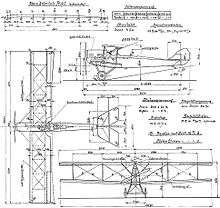SIA 7
| SIA 7 | |
|---|---|
 | |
| S.I.A. 7B | |
| Role | Reconnaissance-bomber |
| National origin | Italy |
| Manufacturer | Società Italiana Aviazione |
| Designer | Torretta and Carlo Maurilio Lerici |
| First flight | Summer 1917 |
| Introduction | 1917 |
| Primary users | Corpo Aeronautico Militare American Expeditionary Force |
| Number built | 572[1] |
|
| |
The SIA 7B was a biplane reconnaissance-bomber built by the Società Italiana Aviazione and served with the Italian Corpo Aeronautico Militare and American Expeditionary Force in 1917.
Development
The engineers, Torretta and Carlo Maurilio Lerici of the Fiat company, designed the airplane as a "Jack of all trades", its speed, climbing power, and carrying capacity enabled it to be used as a bomber and racer.[2] It was built in the workshops of the Societa Italiano Aviazione, a sister company to the famous motor-car firm F.I.A.T. of Turin.[2] It used the standard Italian structural feature of a plywood-covered fuselage.[3]
The SIA.7B was accepted for the Italian Air Force in November 1917 and entered mass production. There were however revealed its shortcomings, like low wing structure durability and poor view.[1] Next variant SIA.7B2, developed in December 1917, had strengthened wings, slightly raised cockpits and stronger engine. Another variant, built in February 1918, was the SIA 9 with stronger 700 hp engine. There were built 501 SIA.7B, 71 SIA.7B2 and 62 SIA.9B.[1]
Operational history
The SIA.7 family aircraft were used for reconnaissance and bombing raids on Austro-Italian front. The SIA.7B2 entered service in March 1918. The SIA.9 managed to take part in World War I service as well. Because of unsatisfactory durability, from July 1918 SIA.7B and 7В2 were moved to training units.
In 1917, the Italian government sent a pair of SIA 7B-1 aircraft to the United States for evaluation under a plan to mass-produce established European designs. The 7B-1 was not put into production in the US but 19 were bought in Italy for use by A.E.F. units sent there.[3]
Variants
- SIA 7B1
- main reconnaissance-bomber variant
- SIA 7B2
- improved reconnaissance-bomber variant
- SIA R2
- scout-bomber built in 1918, span 12.32 m (40 ft 5 in), length 8.75 M (28 ft 8 in), height 3.3 m (120 ft 10 in), speed 180 km/h (111.8 mph)[2]
- SIA 9B
- two-seat reconnaissance-bomber 700 hp (522 kW) Fiat A.14 engine[2]
Operators
- American Expeditionary Forces received 19 7B-1 in February 1917, used at Foggia, Italy.[4]
Specifications (7B)

Data from "United States Military Aircraft Since 1909"[3]
General characteristics
- Crew: 2
- Length: 9.07 m (29 ft 9 in)
- Wingspan: 13.3 m (43 ft 8 in)
- Height: 3.24 m[1] ()
- Wing area: 42.74 m2 (460 ft2)
- Empty weight: 750 kg [1] ()
- Loaded weight: 1,566.7 kg (3,454 lb [5])
- Powerplant: 1 × Fiat A.12 bis 6-cylinder straight engine, 300 hp (223.7 kW)
Performance
- Maximum speed: 200 km/h (124 mph, 107.8 knots)
- Cruise speed: 178.6 km/h (111 mph, 96.5 knots)
- Service ceiling: 6,750 m [1] ()
- Rate of climb: 244 ()
- endurance: 6 hours [1]
Armament
- One observer's 6.5 mm Fiat-Revelli machine gun (flexible)
- 60 kg bombs [1]
See also
Notes
References
| Wikimedia Commons has media related to SIA 7. |
- SIA.7(9) at Ugolok Neba (Russian)
- "United States Military Aircraft Since 1909" by F. Gordon Swanborough & Peter M. Bowers (Putnam New York, ISBN 0-85177-816-X) 1964, 596 pp.
- "Janes Fighting Aircraft of World War I" by Michael John Haddrick Taylor (Random House Group Ltd. 20 Vauxhall Bridge Road, London SW1V 2SA, 2001, ISBN 1-85170-347-0), 320 pp.
- "U.S. Army Aircraft 1908–1946" by James C. Fahey (Ships and Aircraft, Fall Church VA) 1946, 64pp.